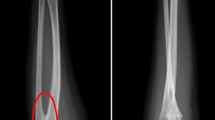Abstract
Mosaicism 45X/47XXX is a sporadic form of ovarian dysgenesis. Many of the cases previously described were characterized by a variable phenotype expression. We here report the case of a 33-yr-old woman with recent secondary amen-orrhea, weight loss and breast regression. Her menarche had occurred at the age of 11 yr and 6 months and her menstrual cycles had been regular until the age of 28; then, oligomenorrhea and hypertricosis developed. A pelvic ultrasound showed enlarged polycystic-like ovaries and normal uterus. She was treated with ethynil-estradiol and cyproterone acetate for one year. At the age of 31 yr, she underwent a pelvic ultrasound — which revealed normal volume of the ovaries — and hormonal assays including FSH (69 UI/l), LH (113 UI/l), 17β-estradiol (88 pg/ml), plasma androgens and cortisol levels within normal ranges. No organ-specific autoantibodies toward ovaries, steroid-producing cells or adrenals were found. At the age of 33 yr, there was ultrasound evidence of streak-like ovaries. The patient’s height was 145 cm and her weight 45 kg. She had normal female external genitalia, abnormal upper-to-lower body segment ratio, webbed neck, low posterior hair line, cubitus valgus, short and asymmetrical 4th metacarpi, hallux with lateral deviation and moderate scoliosis. No increase in ovarian steroids were found after GnRH-analogue triptorelin (0,1 mg sc) administration. The karyotype analysis on peripheral blood lymphocytes showed a mosaic 45X (90% cells) and 47XXX (10% cells). Diagnostic pelviscopy confirmed streak gonads. Chronic lymphocytic thyroiditis was diagnosed but no cardiovascular or kidney abnormalities were found. A neuro-psychological evaluation revealed emotional and social immaturity, disorders in motorial coordination, visual-spatial organization, as well as reading difficulties and impaired complex phrase construction. The presence of several somatic features of Turner’s syndrome, neuro-psychological disorders and an interesting natural history probably depended on the quantitative proportion of 45X to 47XXX cell-lines in different tissues and organs. Estrogen and progestin replacement therapy led to weight gain, re-appearance of secondary sexual characteristics and a mild improvement in mental equilibrium.
Similar content being viewed by others
References
Nielsen J., Wohlert M. Chromosome abnormalities found among 34910 newborn children: Results from a 13-year incidence study in Aarhus, Denmark. Hum. Genet. 1991, 87: 81–83.
Azcona C., Bareille P., Stanhope R. Turner’s syndrome mosaicism in patients with normal blood lymphocyte karyotype. BMJ 1999, 318: 856–857.
Saenger P. Turner’s syndrome. N. Engl. J. Med. 1996, 335: 1749–1754.
Lippe B. Turner’s syndrome. Endocrinol. Metab. Clin. North Am. 1991, 20: 121–152.
Mathur A.S., Stekol L., Schatz D., Mc Laren N.K., Scott M.L., Lippe B. The paternal origin of the single X chromosome in Turner’s syndrome: Lack of correlation with paternal age or clinical phenotype. Am. Hum. Genet. 1991, 48: 682–686.
Grumbach M.M., Conte F. Disorders in sex differentiation. In: Wilson J.D., Foster D.W. (Eds.), Williams textbook of endocrinology, ed. 8. W.B. Saunders, Philadelphia, 1992, p. 853.
Ogata T., Matsuo N. Turner syndrome and female sex chromosome aberrations: deduction of the principal factors involved in the development of clinical features. Hum. Genet. 1995, 95: 607–629.
Turner H.A. A syndrome of infantilism, congenital webbed neck and cubitus valgus. Endocrinology 1938, 23: 566–574.
Elsheilh M., Conway G.S., Wass J.A., Medical problems in adult women with Turner’s syndrome. Ann. Med. 1999, 2: 99–105.
Gelfand R.A. Cushing’s disease associated with ovarian dysgenesis. Am. J. Med. 1984, 77: 1108–1110.
Adams J., Polson D.W., Franks S. Prevalence of polycystic ovaries in women with anovulation and idiopathic hirsutism. BMJ 1986, 293: 355–359.
Tauchmanovà L., Rossi R., Coppola A., Luciano A., Del Viscovo L., Soriente L., De Bellis A., Di Minno G., Lombardi G. Antiphospholipid syndrome, adrenal failure, dilated cardiomyopathy and chronic hepatitis: an unusual manifestation of multiorgan autoimmune injury? Eur. J. Endocrinol. 1998, 139: 641–645.
De Bellis A., Bizzarro A., Rossi R., Paglionico V.A., Criscuolo T., Lombardi G., Bellastella A. Remission of subclinical adrenocortical failure in subjects with adrenal autoantibodies. J. Clin. Endocrinol. Metab. 1993, 76: 1002–1007.
Rossi R., Tauchmanovà L., Luciano A., Di Martino M., Savastano S., Valentino R., Lombardi G. Functional hyperandrogenism detected by corticotropin and GnRH-analogue stimulation tests in women affected by apparently idiopathic hirsutism. J. Endocrinol. Invest. 2001, 24: in press.
Jacobs P., Betts P.R., Cockwell A.E., Crolla J.A., Mackenzie M.J., Robinson D.O., Youings S.A. A cytogenetic and molecular reappraisal of a series of patients with Turner’s syndrome. Ann. Hum. Genet. 1990, 54: 209–223.
Binder G., Koch A., Wajs E., Ranke M.B. Nested polymerase chain reaction study of 53 cases with Turner’s syndrome: Is cytogenetically undetected Y mosaicism common? J. Clin. Endocrinol. Metab. 1995, 80: 3532–3536.
Lindgren R., Gunnarsson C., Jakobsson A., Hammar M. Hypersecretion of ovarian androgens may be gonadotropin dependent many years after menopause. Maturitas 2000, 34: 43–46.
Judd H.L., Fournet N. Changes of ovarian function with ageing. Review. Exp. Gerontol. 1994, 29: 285–98.
Skuse D.H., James R.S., Bishop D.V., Coppin B., Dalton P., Aamodt-Leeper G., Bacarese-Hamilton M., Creswell C., McGurk R., Jacobs P.A. Evidence from Turner’s syndrome of an imprinted X-linked locus affecting cognitive function. Nature 1997, 387: 705–708.
Robinson A., Lubs H.A., Nielsen J., Sorensen K. Summary of clinical findings: profiles of children with 47,XXY, 47,XXX, and 47,XYY karyotypes. Birth Defects Orig. Art. Ser. 1979, 15: 261–266.
Moroshima A., Grumbach M.M. The interrelationship of sex chromosome constitution and phenotype in the syndrome of gonadal dysgenesis and its variants. Ann. NY Acad. Sci. 1968, 155: 695–715.
Jacobs P.A. Change of human chromosome count distributions with age: evidence for a sex difference. Nature 1963, 197: 1080–1082.
Ferguson-Smith M.A. Genotype-phenotype correlations in individuals with disorders of sex determination and development including Turner’s syndrome. Semin. Dev. Biol. 1991, 2: 265–276.
Author information
Authors and Affiliations
Corresponding author
Rights and permissions
About this article
Cite this article
Tauchmanovà, L., Rossi, R., Pulcrano, M. et al. Turner’s syndrome mosaicism 45X/47XXX: An interesting natural history. J Endocrinol Invest 24, 811–815 (2001). https://doi.org/10.1007/BF03343932
Accepted:
Published:
Issue Date:
DOI: https://doi.org/10.1007/BF03343932




